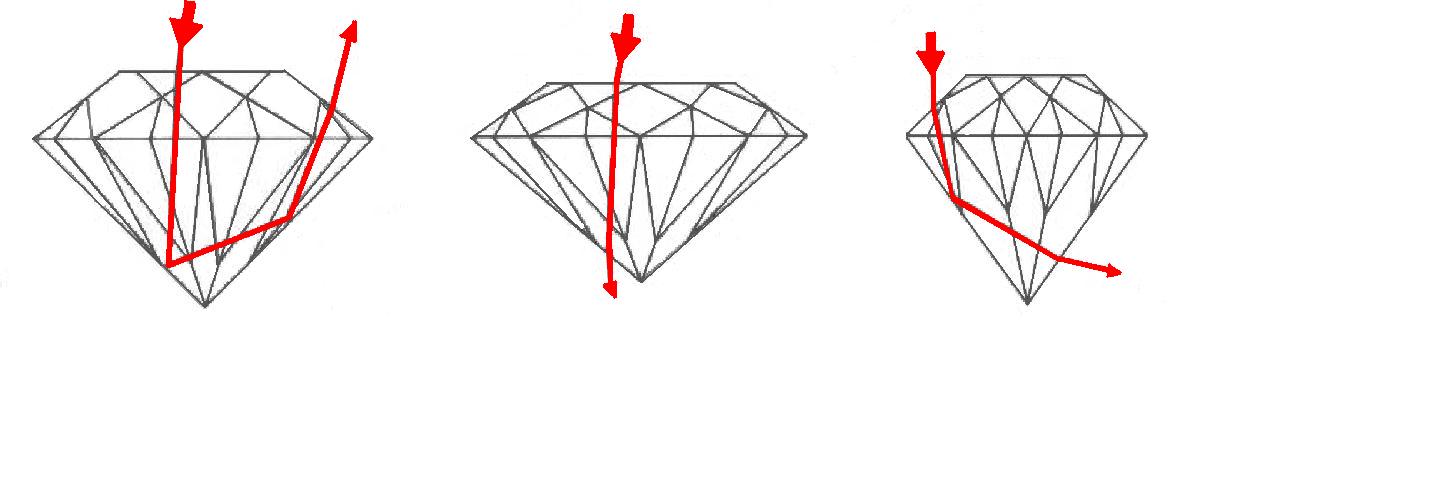The diamond make refers to the overall quality of the cut of a diamond, evaluating how well it has been shaped and finished. This includes an assessment of the proportions, symmetry, and polish of the diamond, all of which contribute to its brilliance, fire, and scintillation (the sparkle of the diamond). The make plays a crucial role in determining the diamond’s visual appeal and its overall value. A well-cut diamond will exhibit optimal light performance, making it appear vibrant and full of life.
Key Aspects of Diamond Make
Proportions:
The proportions of a diamond are crucial to its overall make. This refers to the specific dimensions of the diamond, including the depth, table, crown angle, pavilion angle, and the girdle. The proportions must be balanced in such a way that they allow for the ideal reflection and refraction of light, maximising the diamond’s brilliance.
Ideal Proportions: For a round brilliant cut diamond, the ideal proportions ensure that light entering the diamond is properly reflected and refracted, bouncing around the facets before exiting through the crown and creating sparkle.
Poor Proportions: A diamond with poor proportions will either leak light out from the bottom (leading to a dark, dull appearance) or fail to reflect light properly (causing a lifeless look).
Symmetry:
Symmetry refers to the precision and alignment of the facets in a diamond. A well-symmetrical diamond ensures that each facet is positioned correctly to reflect light at the right angles. For round brilliant cuts, symmetry affects how well the facets align to create the signature sparkle. Any asymmetry, such as off-centre facets or mismatched angles, will interfere with the flow of light and negatively impact the diamond’s overall performance.
Ideal Symmetry: A diamond with excellent symmetry will display uniformity across all facets, contributing to a balanced distribution of light and a consistent sparkle.
Poor Symmetry: A diamond with poor symmetry may display uneven facets, which can affect the visual appearance and reduce its brilliance.
Polish:
Polish refers to the smoothness and finish of the diamond’s surfaces, including the crown, pavilion, and girdle. A well-polished diamond allows light to pass through smoothly, enhancing its brilliance and preventing light from being blocked by rough or uneven surfaces.
Ideal Polish: Diamonds with excellent polish will have a smooth, flawless surface that reflects light optimally. There will be no visible abrasions, scratches, or imperfections on the surface.
Poor Polish: If the diamond is poorly polished, the surface may have visible blemishes, which can distort the light and detract from the diamond’s overall sparkle.
Cut Grade:
The cut grade is a composite evaluation that includes the proportions, symmetry, and polish of the diamond. Diamond grading laboratories, such as the Gemological Institute of America (GIA), assign cut grades that range from Excellent to Poor based on these factors. A diamond with an excellent cut will showcase ideal proportions, symmetry, and polish, leading to superior brilliance and fire.
Ideal Cut: A diamond with an ideal cut is precisely shaped to reflect light in the most efficient way, maximising its brilliance and visual appeal.
Good/Very Good Cut: These diamonds may have minor deviations from ideal proportions or symmetry, but they still exhibit strong light performance.
Fair/Poor Cut: These diamonds have significant deviations from the ideal, which can lead to dull or lifeless appearances.
Impact of Diamond Make on Light Performance
The make of a diamond directly influences how light is handled by the stone. When light enters a diamond, it travels through the crown and pavilion before exiting, either through the top (creating brilliance) or dispersing into a spectrum of colours (creating fire). The cut quality determines how well this light is managed and returned to the observer’s eye.
Brilliance:
A diamond’s brilliance is the amount of white light it reflects. A well-cut diamond with excellent proportions and symmetry will reflect light efficiently, leading to a bright and lively appearance.
Fire:
Fire refers to the dispersion of light into a spectrum of colours, similar to a rainbow. Diamonds with an excellent make will show vibrant flashes of colour, enhancing the overall beauty and desirability of the stone.
Scintillation:
Scintillation refers to the flashes of light seen when the diamond moves. A well-cut diamond will exhibit a high degree of scintillation, making it appear sparkling and dynamic as it shifts in the light.
Importance of Diamond Make in Valuation
The make of a diamond significantly affects its value. Diamonds with excellent makes are highly sought after and are often priced higher because they exhibit superior light performance and visual appeal. In contrast, diamonds with poor makes may be priced lower due to their less-than-optimal appearance.
High-Quality Make: Diamonds with excellent cuts, symmetry, and polish will be more valuable due to their superior brilliance, fire, and scintillation. These diamonds are also more desirable to consumers, who often seek the most visually stunning stones.
Low-Quality Make: Diamonds with poor cuts, imbalanced proportions, or visible imperfections on the surface will likely be less valuable. These diamonds do not reflect light as efficiently, resulting in a duller appearance and lower demand in the market.
